Page Table of Contents
About the Author
Hot Topics
Updated on May 23, 2024
If you don't have room on your computer for new applications or games, or if the clutter on your hard drive is driving you crazy, you're not alone. This article will give you ten ways to help free up hard drive space in Windows 10/11. Let's start!
What's Taking Up My Hard Drive Space?
During your daily use of your computer, you may notice that your hard disk space disappears and think, "What is taking up space on my hard drive?" It can be difficult to tell what is taking up disk space by looking at the installed applications and the files saved in Windows Explorer. Fortunately, Windows can help you solve the problem and check total disk space Windows 11.
Go to Settings > System > Storage, and you will see all the drives listed there. You can select a drive to see what is taking up space.
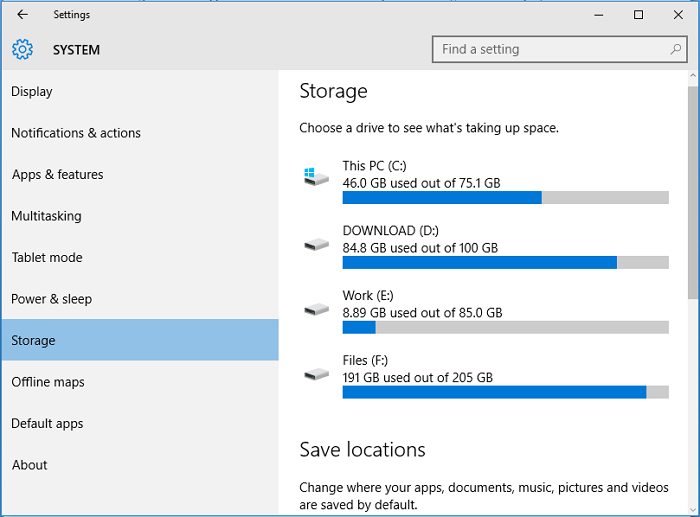
In addition, you can even click through each item to get a more in-depth look at how much disk space the application/game is taking up. After knowing the rest space, however, how to free up hard drive space in Windows 10/11? You can learn a lot about it in the next part.
By the way, we prepare some links for you since you may also like to know:
Ten Ways to Free Up Hard Drive Space in Windows 10/11
With the introduction of SSDs (solid state drives) that have less space to load than traditional mechanical hard drives, combined with games and applications that require more and more disk space, your hard drive can easily become full. This part provides ten ways to help you and now, let's see what they are:
Way 1. Extend Hard Drive Partitions
Way 2. Use Storage Sense to Delete Unnecessary Files
Way 3. Uninstall Apps You No Longer Need
Way 7. Disable Hibernation Mode
Way 9. Turn on OneDrive Files On-Demand
Way 10. Reduce the Size of the WinSxS Folder
You can try the ten ways to free up hard drive space. Now, we will guide you on each way step-by-step.
Way 1. Extend Partitions via EaseUS Partition Master
In this way, you may like to know a professional disk management tool for Windows, EaseUS Partition Master Professional. It is easy to use with a clear interface. EaseUS Partition Master can help you extend partitions to get more space, which is more efficient and effective than freeing up space in other ways. Now, download it and follow these steps to get more space for your hard drive.
Step 1. Locate the Target Partition.
Go to Partition Manager, locate the target partition and select "Resize/Move".
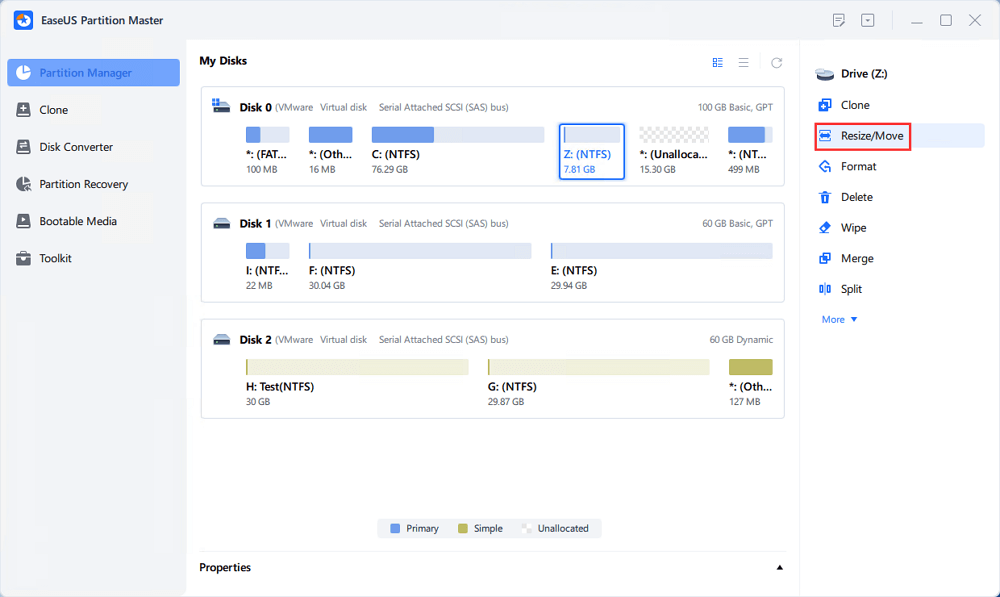
Step 2. Extend the Target Partition.
Drag the partition panel rightward or leftward to add the unallocated space into your current partition and click "OK" to confirm.
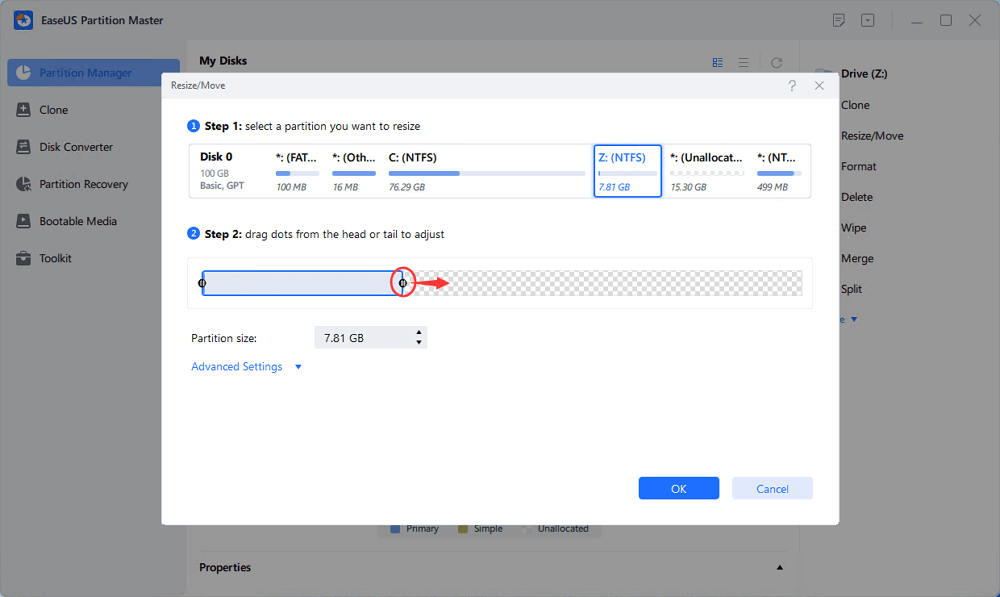
Extra Option: Get Space from Another Drive
If there is not enough unallocated space on your disk, right-click on a big partition with enough free space, select "Allocate space".
Then select the target partition that you want to extend at the allocate space to column.
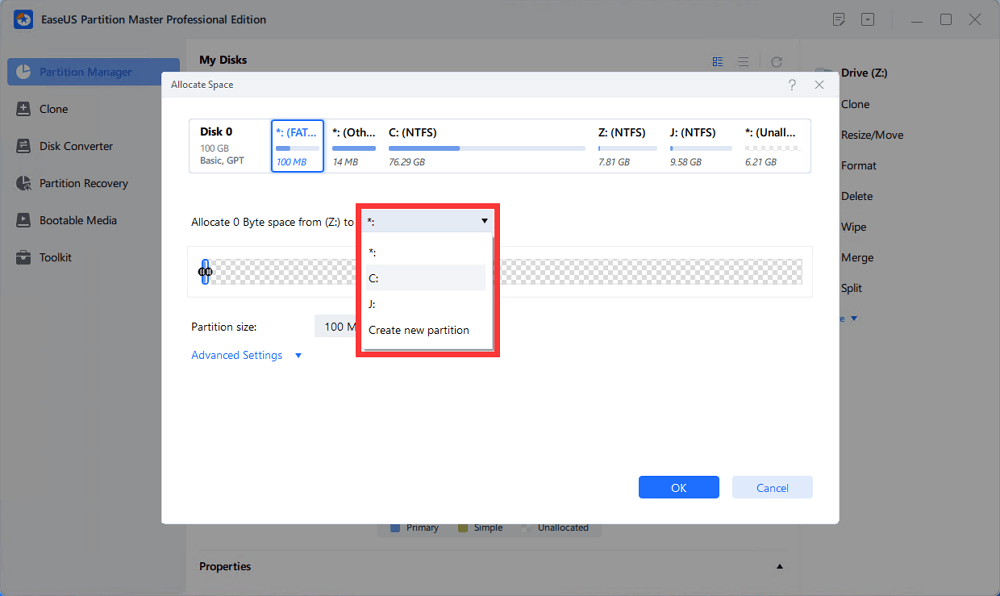
Step 3. Execute Operations to Extend Partition.
Drag the dots of the target partition into the unallocated space and click "OK".
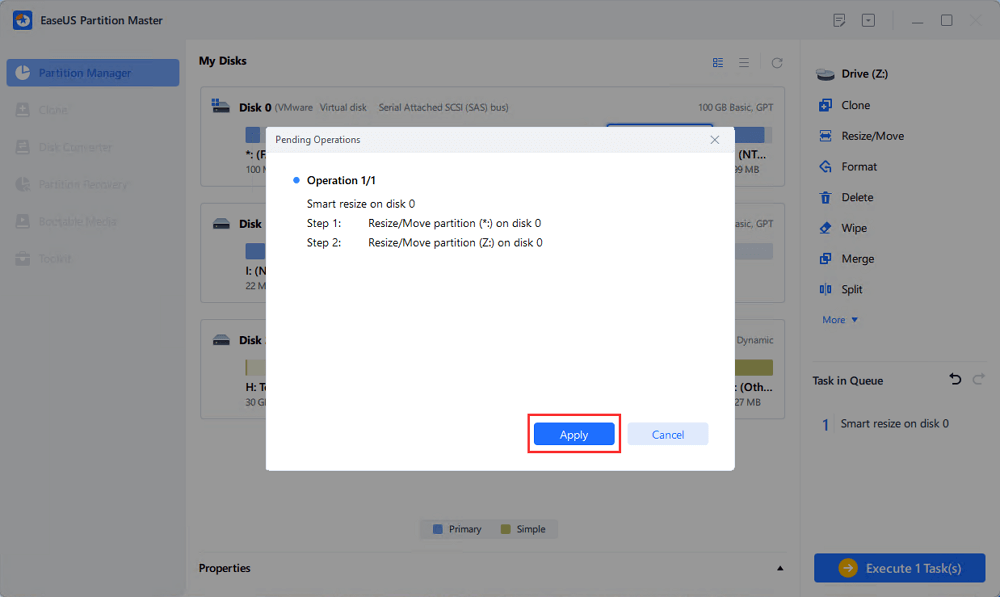
Then Click the "Execute Task" button and click "Apply" to keep all the changes.
Besides this, EaseUS Partition Master still gets many other features to manage your hard drive, such as:
- Migrate OS to SSD/HDD
- Expand SSD C drive across disks
- Format and reformat hard drive
- Move, merge, resize, and create partitions
- Move space from D to C to extend your C drive
You see! It is a nice helper, isn't it? Hence, don't hesitate to download it to help.
Way 2. Use Storage Sense to Delete Unnecessary Files
Storage Sense was introduced in the Windows 10 release to clear the Recycle Bin of temporary files and contents. If you turn on Storage Sense in Settings, Windows can automatically free up disk space by deleting files you don't need.
If the Storage Sense is still off, you can make it work.
Step 1. Go to Start Menu > Settings > System > Storage. Turn the Storage Sense on and click the "Change how we free up space" option.

Step 2. In the next window, check the type of temporary files you want to delete. You can free up disk space by pressing "Clean up now" immediately.

Way 3. Uninstall Apps You No Longer Need
If you have installed some programs that you no longer need them now, you can uninstall them to free up space on your hard drive.
Step 1. Right-click the Windows Start menu and click the "Apps & Features" option.
Step 2. Then choose the program you no longer need and select Uninstall.
Step 3. You can repeat this process to remove all unnecessary applications.
Way 4. Transfer Larger Files
You can also transfer large files from one drive to another to free up more space. There is a nice and professional computer transfer software, EaseUS Todo PCTrans. It can help you efficiently transfer large files and programs to another hard drive. Let's learn how you can use it to help.
Step 1. Run EaseUS Todo PCTrans on your PC. Choose "Large File Cleanup" > Click "Start" button to move on.
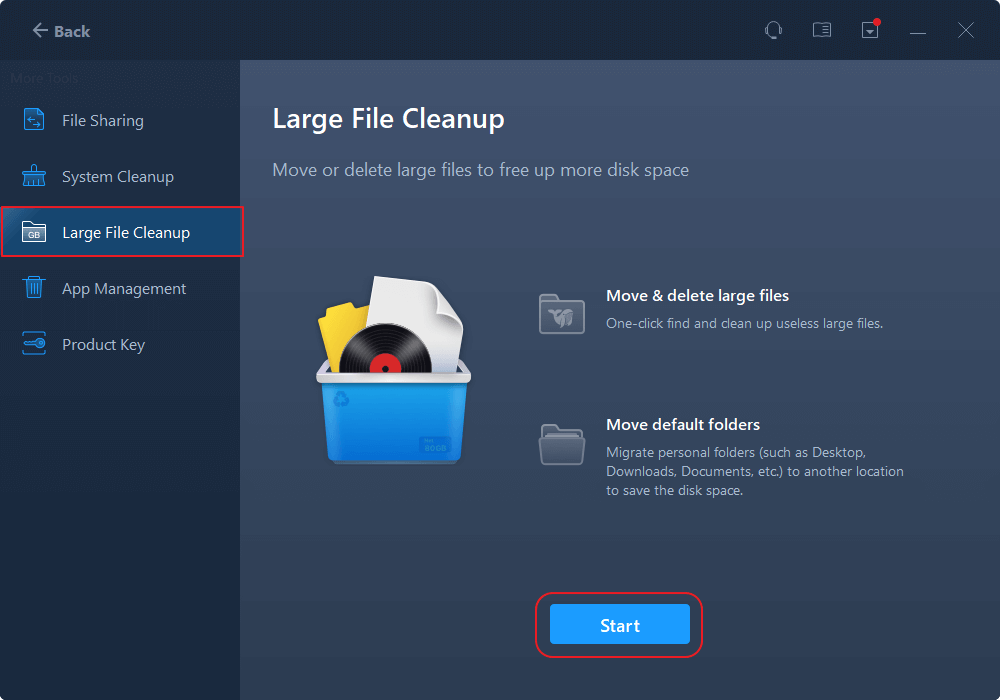
Step 2. Select the disk you want to scan, click "Scan."
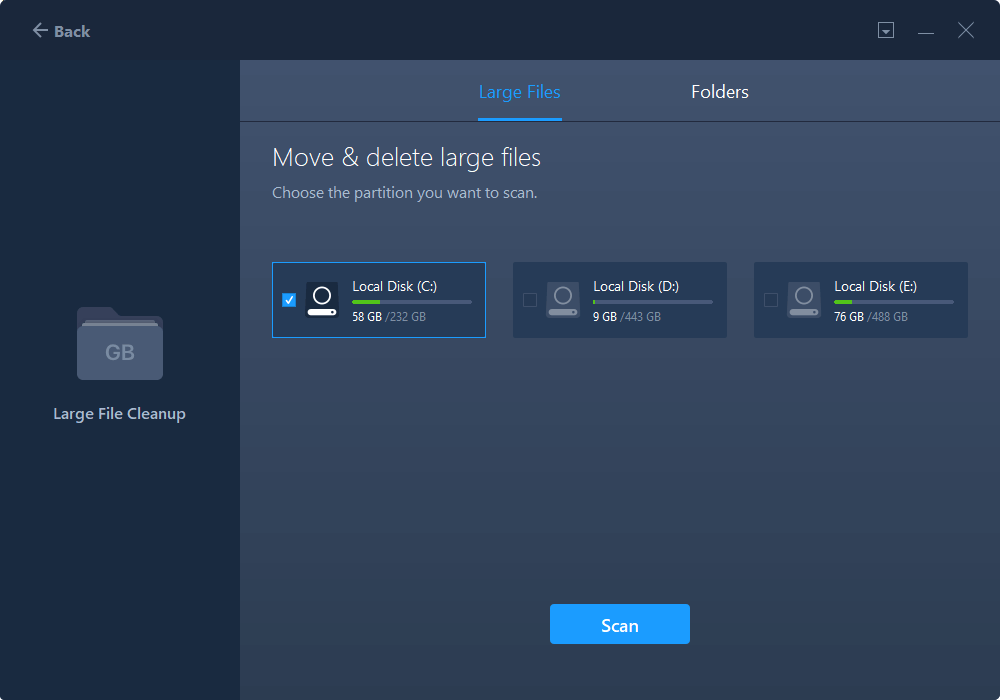
Step 3. When the scan completes, files larger than 20M will be listed. Choose the wanted files and target drive to move. (You can choose the triangle icon to select destination or click "Browse" to pick the wanted place.)
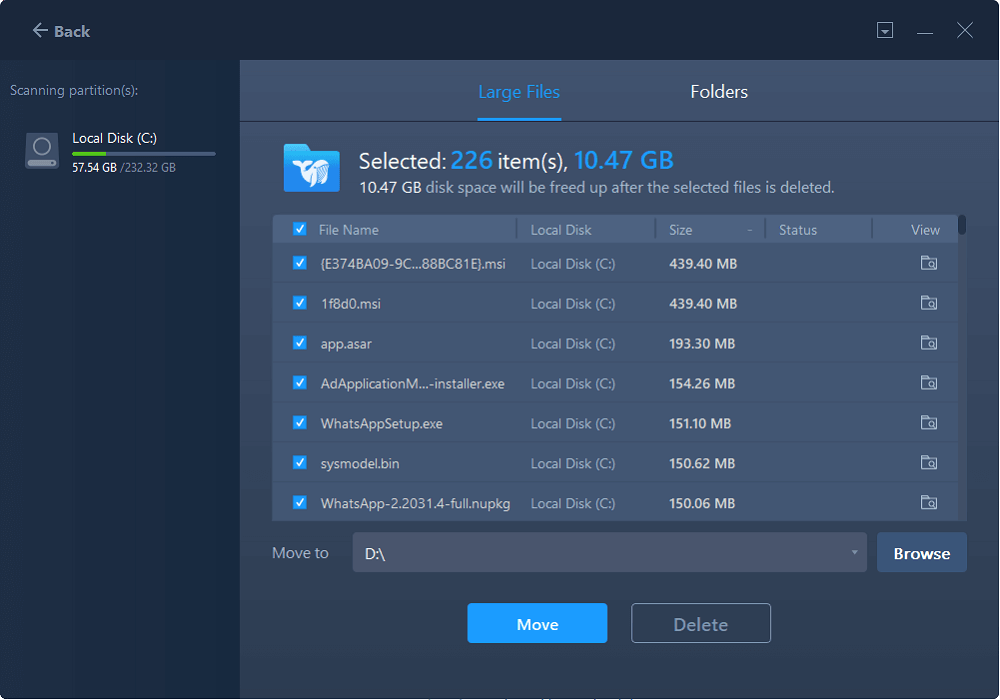
Step 4. Click "Move" button, then check files on the pop window. Then click "Move" button again.
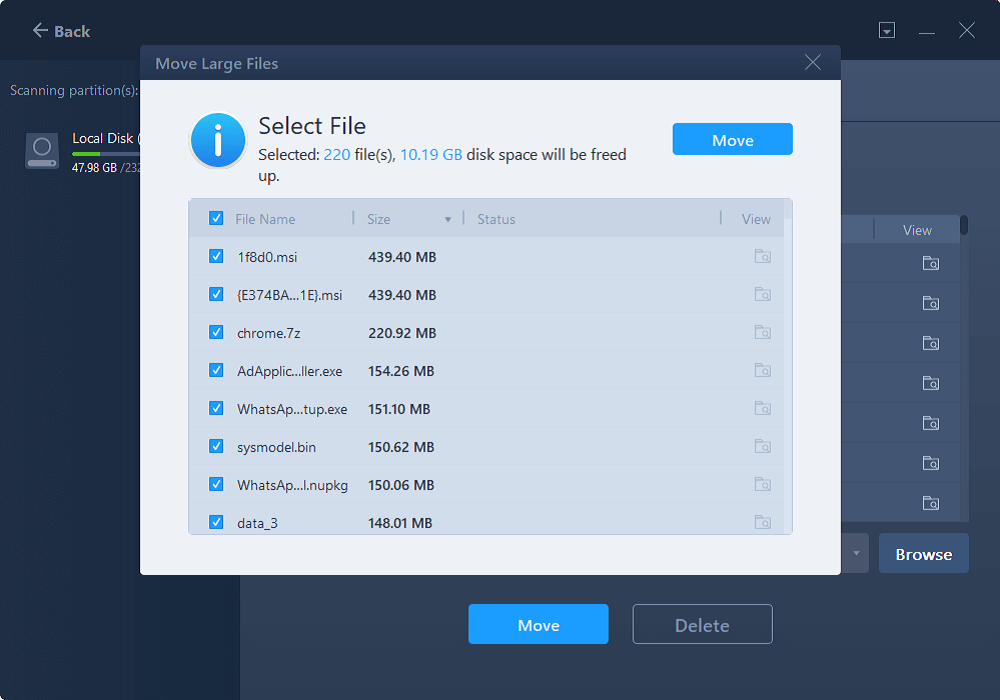
Way 5. Empty Recycle Bin
We already mentioned emptying the Recycle Bin in Method 2, but Storage Sense is only able to clear the last thirty days of files in the Recycle Bin. Follow this instruction to start emptying your Recycle Bin completely.
Step 1. Click the "Recycle Bin" icon on your desktop.
Step 2. Select all the files in your Recycle Bin, right-click on them, and click "Delete."
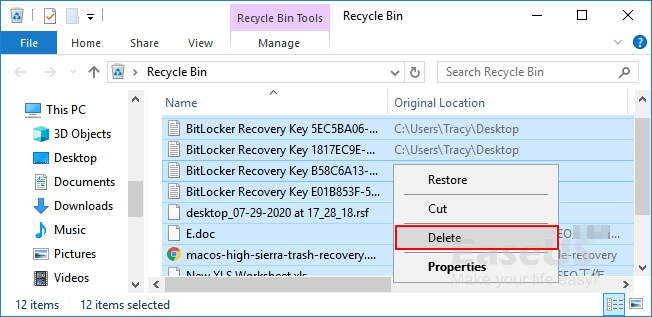
Way 6. Run Disk Cleanup
Windows comes with a lot of great tools to help you keep your computer storage tidy. Disk Cleanup is one of these utilities. It allows you to delete data, such as temporary files, which can reach gigabytes (GB) over time. Please follow the steps to try it.
Step 1. Click on "This PC." Then right-click on the targeted hard drive and choose Disk Cleanup.
Step 2. Choose what you want to delete and click "OK".
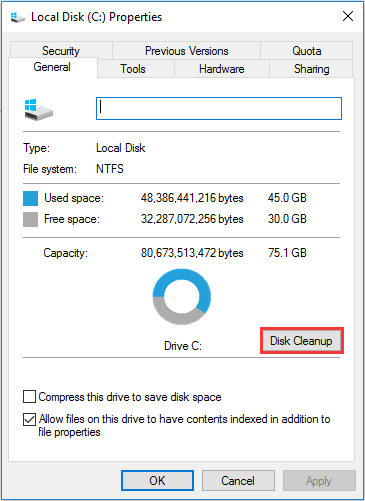
In addition to this built-in Windows utility, you can also check the following page to learn more free disk cleaner options.

Top 5 Best Free Disk Cleaner Software
This article includes 5 free disk cleaners that can help you solve the low disk space issue. Continue reading and make your choice. Read more >>
Way 7. Disable Hibernation Mode
The Hibernation Mode in computing allows the process of powering off the computer while maintaining its state. If you enable hibernate mode in Windows, it will also take up several GB of space on your C drive, so please follow this guide to disable it.
Simply open CMD and run the following command:
powercfg /hibernate off

Way 8. Enable Compact OS
Compact OS can reduce the footprint of the applications in Windows to free up disk space, which makes sense when it comes to Windows disk cleanup. However, before using it, be careful to back up important data on the target disc.
Step 1. Search for Command Prompt and select the "Run as administrator" option.
Step 2. Then, type the following command and press Enter: Compact.exe/CompactOS:always
Be patient for about twenty minutes.

Way 9. Turn on OneDrive Files On-Demand
You can free up your disk drive space by turning on OneDrive Files On-Demand. With this feature enabled, you can access OneDrive files from your PC while you don't have to download them all, which will free up a lot of disk space. Let's start.
Step 1. Click the OneDrive icon to open it and sign in to your account.
Step 2. Right-click the OneDrive icon and select Settings.
Step 3. Navigate to the Settings tab and make sure the "Save space and download files when you use them" option is checked.

Step 4. Open your OneDrive, select all files and folders, open the context menu and select the "Clear Space" option. In this way, all files are saved in the cloud, freeing up space on your Windows disk.
Way 10. Reduce the Size of the WinSxS Folder
If the C drive keeps filling up, you can find a folder named "WinSxS." By looking at its properties, you will see that it takes up quite a bit of disk space. Follow this guide to free up your disk space.
Step 1. Go to the "Control Panel."
Step 2. Set it to view by category and select "System and Security."
Step 3. Select "Scheduled Tasks" under the "Administrative Tools" section.

Step 4. In the left panel, click Task Scheduler Library > Microsoft > Windows > Servicing.
Step 5. Right-click on "StartComponentCleanup" in the middle panel and select "Run."

You may also like:
Conclusion
In this article, we show you ten ways to free up hard drive space. You can choose a simple method if you need it. Well, if you have other questions about releasing disk space, please continue reading the next paragraph.
FAQs About Free Up Hard Drive Space
This part lists three questions related to freeing up hard drive space in Windows, so continue to read if you need.
1. Why is my C drive full?
Most of the time, useless large junk files, big files, huge installers, and temporary files take up most of the space on your system's C drive after using your computer for a long time.
2. What can I delete from C drive?
You can delete many files, including Recycle Bin files, upgrade log files, device driver packages, Windows Update cleanup files, temporary Internet files, and other temporary files.
3. How do you find out what is taking up disk space?
You can follow this path to check:
Go to Settings > System > Storage, and you will see all the drives listed there. You can select a drive to see what is taking up space.
How Can We Help You
About the Author
Oliver is an EaseUS professional writer who dares explore new areas. With a passion for solving tech issues with straightforward guides for common users, Oliver keeps honing his writing craft by developing in-depth solutions for disk and partition management, computer boot-up issues, file transfer, etc.
Sherly joined EaseUS in 2022 and she has always loved writing articles and enjoys the fun they bring. She receives professional training here, focusing on product performance and other relative knowledge. She has written over 200 articles to help people overcome computing issues.
Product Reviews
-
I love that the changes you make with EaseUS Partition Master Free aren't immediately applied to the disks. It makes it way easier to play out what will happen after you've made all the changes. I also think the overall look and feel of EaseUS Partition Master Free makes whatever you're doing with your computer's partitions easy.
Read More -
Partition Master Free can Resize, Move, Merge, Migrate, and Copy disks or partitions; convert to local, change label, defragment, check and explore partition; and much more. A premium upgrade adds free tech support and the ability to resize dynamic volumes.
Read More -
It won't hot image your drives or align them, but since it's coupled with a partition manager, it allows you do perform many tasks at once, instead of just cloning drives. You can move partitions around, resize them, defragment, and more, along with the other tools you'd expect from a cloning tool.
Read More
Related Articles
-
How to Fix HP Laptop Running Slow on Windows 11/10 [2024 Newest]
![author icon]() Cici/2024/04/26
Cici/2024/04/26 -
How to Clone Raspberry Pi SD Card in Windows 11/10/8/7 [Detailed Guide]
![author icon]() Sherly/2024/04/22
Sherly/2024/04/22 -
[New] How to Add Unallocated Space to C Drive in Windows 10
![author icon]() Brithny/2024/04/22
Brithny/2024/04/22 -
5 Methods to Fix Bootrec /Fixboot Access Is Denied Windows 11
![author icon]() Oliver/2024/05/22
Oliver/2024/05/22
Hot Topics in 2024
EaseUS Partition Master

Manage partitions and optimize disks efficiently








